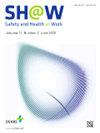Ineffectiveness of Water Mist Spray to the Upper Body of Healthy Adults in Suppressing Core Temperature Under Windless Environment
IF 2.9
3区 医学
Q1 PUBLIC, ENVIRONMENTAL & OCCUPATIONAL HEALTH
引用次数: 0
Abstract
Background
Global warming has increased heat-related illness concerns. Water misting is used for workplace cooling, but its effect on core body temperature is unclear.
Methods
We examined whether spraying water mist on the upper body suppresses the increase in core body temperature in hot and humid environments. Nine healthy adult men exercised for 60 min on a bicycle ergometer at four metabolic equivalents under two conditions: warm-humid environment (30 °C ambient temperature [Ta], 85% relative humidity [RH]) and hot-dry (HD) environment (40 °C Ta, 30% RH). Water mist (MIST) or no mist (CON) was applied to the back of the head, neck, and dorsum of hands every 10 min.
Results
Rectal temperature changes were similar between conditions, but peak temperatures were slightly higher with MIST (38.32°C vs. 38.14°C, p = 0.074) in HD environments. The estimated sweat volume was lower with MIST, especially in HD settings.
Conclusion
Water mist does not prevent core temperature increases and should be avoided in extremely hot environments.
无风环境下健康成人上半身水雾喷雾抑制核心温度的无效研究
全球变暖增加了人们对热相关疾病的担忧。水雾用于工作场所降温,但其对核心体温的影响尚不清楚。方法观察在湿热环境下,上半身喷洒水雾是否能抑制核心体温的升高。9名健康成年男性在两种条件下,分别在四种代谢当量的自行车测力器上锻炼60分钟:暖湿环境(30°C环境温度[Ta], 85%相对湿度[RH])和干热环境(40°C环境温度,30%相对湿度)。每10分钟用水雾(mist)或无雾(CON)涂抹于后脑、颈、手背。结果两种条件下的直肠温度变化相似,但HD环境下MIST的峰值温度略高(38.32°C vs. 38.14°C, p = 0.074)。MIST估计的汗液量较低,特别是在高清设置中。结论水雾不能有效防止核心温度升高,应避免在极热环境中使用。
本文章由计算机程序翻译,如有差异,请以英文原文为准。
求助全文
约1分钟内获得全文
求助全文
来源期刊

Safety and Health at Work
Social Sciences-Safety Research
CiteScore
6.40
自引率
5.70%
发文量
1080
审稿时长
38 days
期刊介绍:
Safety and Health at Work (SH@W) is an international, peer-reviewed, interdisciplinary journal published quarterly in English beginning in 2010. The journal is aimed at providing grounds for the exchange of ideas and data developed through research experience in the broad field of occupational health and safety. Articles may deal with scientific research to improve workers'' health and safety by eliminating occupational accidents and diseases, pursuing a better working life, and creating a safe and comfortable working environment. The journal focuses primarily on original articles across the whole scope of occupational health and safety, but also welcomes up-to-date review papers and short communications and commentaries on urgent issues and case studies on unique epidemiological survey, methods of accident investigation, and analysis. High priority will be given to articles on occupational epidemiology, medicine, hygiene, toxicology, nursing and health services, work safety, ergonomics, work organization, engineering of safety (mechanical, electrical, chemical, and construction), safety management and policy, and studies related to economic evaluation and its social policy and organizational aspects. Its abbreviated title is Saf Health Work.
 求助内容:
求助内容: 应助结果提醒方式:
应助结果提醒方式:


